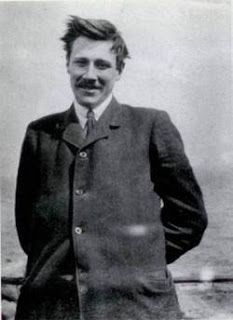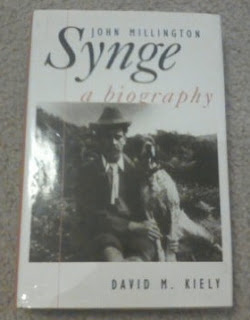This review was written in 2009
Bought in the second hand
bookshop in Abbey Street near O’Connell Street in April 2010 where a great
selection of books is available for as little as 6 or 7 Euros. This volume cost
E5.99. I was perfectly aware of the important part Synge played in the
development of the Abbey Theatre and of his close association with W. B. Yeats
and Lady Gregory. I had not read a biography of his before but I was of course
aware of his very controversial role as a playwright. His Playboy of the
Western World was the first play to lead to controversy among the Catholic and
Nationalist population of Dublin and it was surprising to me that Arthur
Griffith was one of its most outspoken and hostile critics. It was Griffith who
lead the campaign against Synge and the Abbey. Synge’s portrayal of the native
people of Ireland, and particularly those in the West and in his native Co. Wicklow, caused great offence to many of Dublin’s citizens, largely because of
his sublects’ earthy and picturesque English language adorned with the Irish idiom.
Many of the Dublin nationalists and Catholics at the time lacked the maturity to
accept Synge’s portrayal of the native Irish country people’s way of life as observed
by his close contact with them.
 |
| Programme from the Abbey theatre in 1907 |
Synge came from a very conservative
protestant family who lived in Dublin and Co. Wicklow and he was in striking
contrast to the anti-Catholic and anti-nationalist members of his privileged
family. He soon became an agnostic, and a thorn in his mother's side who was
extremely conservative in her devotion to her religion and was part of the
anti-Catholic tradition of her privileged class. Synge became absorbed by the
local population and spent his time in lonely walks around the Co. Wicklow and subsequently
in the Aran Islands, Connemara and the Dingle Peninsula. He was remarkable in
his attachment to the native people in Ireland, to their dialect and to their
conversation in English based on the Irish Idiom and full of the colourful
allusions of a primitive rural class who had little intellectual contact with
the outside world. In his earlier years Synge travelled widely in Germany,
France, Italy and England and added German and French to English and to the Irish
he learned in Inishmaan in Aran. He was a product of the limited number of landed
gentry and the Protestant minority who were to become involved in the cultural
Celtic Revival and who were likely to be more nationalistic and more in favour
of Home Rule than most of their brethren.
 |
| John Milliton Synge |
Kiel’s book was absorbing and
worth reading. It is worth a more detailed review, if only because Synge's life
gives a clue to the importance of the cultural revival at the turn of the
century which involved some of the Protestant minority whose increasing
commitment to Irish culture and identity might have played a crucial part in the
emergence of Ireland as a self-ruling 32-country in happy co-existence with
Catholic, Anglican and non-conformist and in a close association with our
neighbouring island and the Commonwealth. All this may have happened were it
not for the misfortune of 1916 and the unhappy consequence of the Civil War and
the division of our country.
Synge died from Hodgkin’s disease
in March 1909 after recurring illnesses in his later years. He is buried in
Mount Jerome cemetery in Harold’s Cross in his family grave.

No comments:
Post a Comment